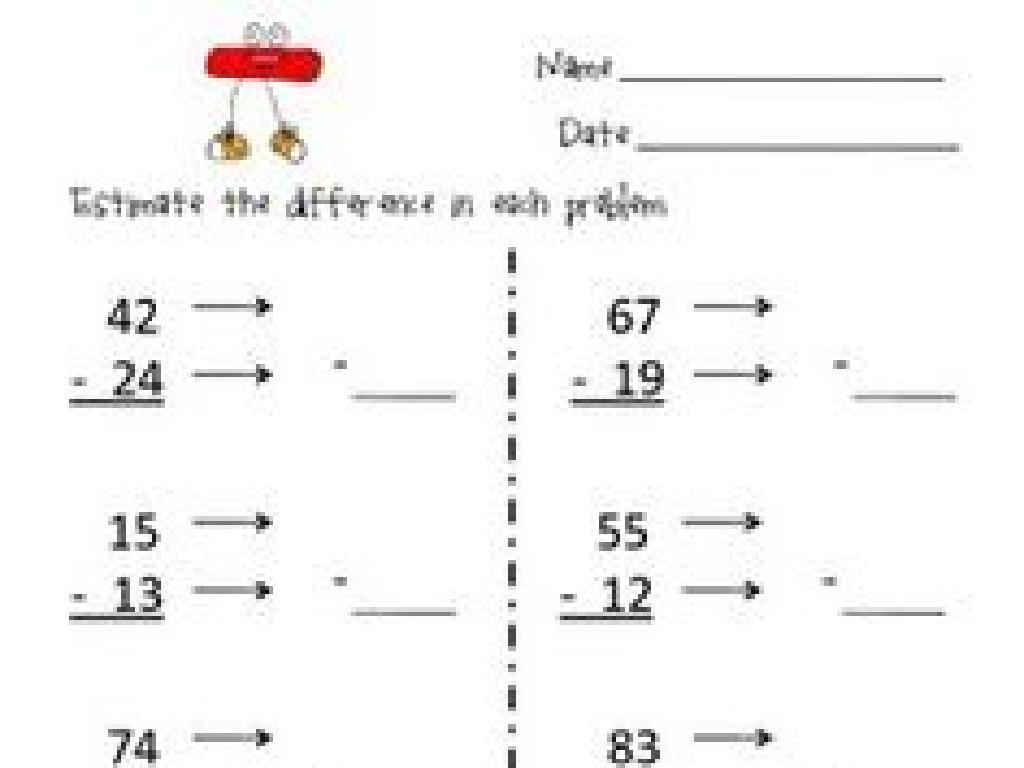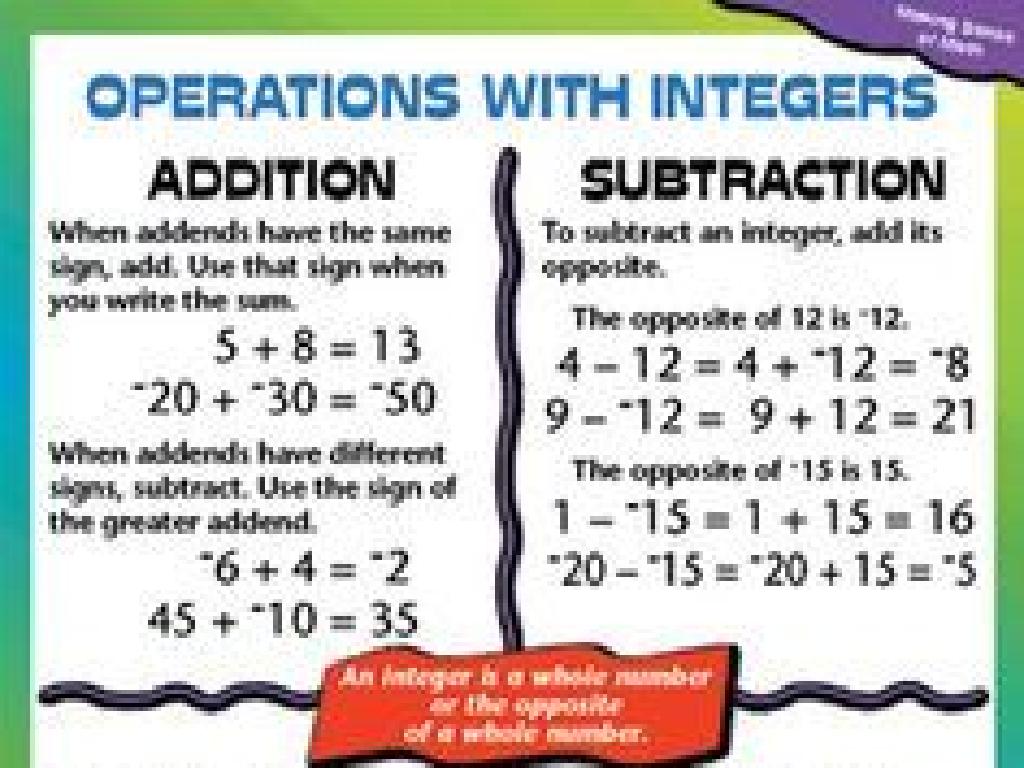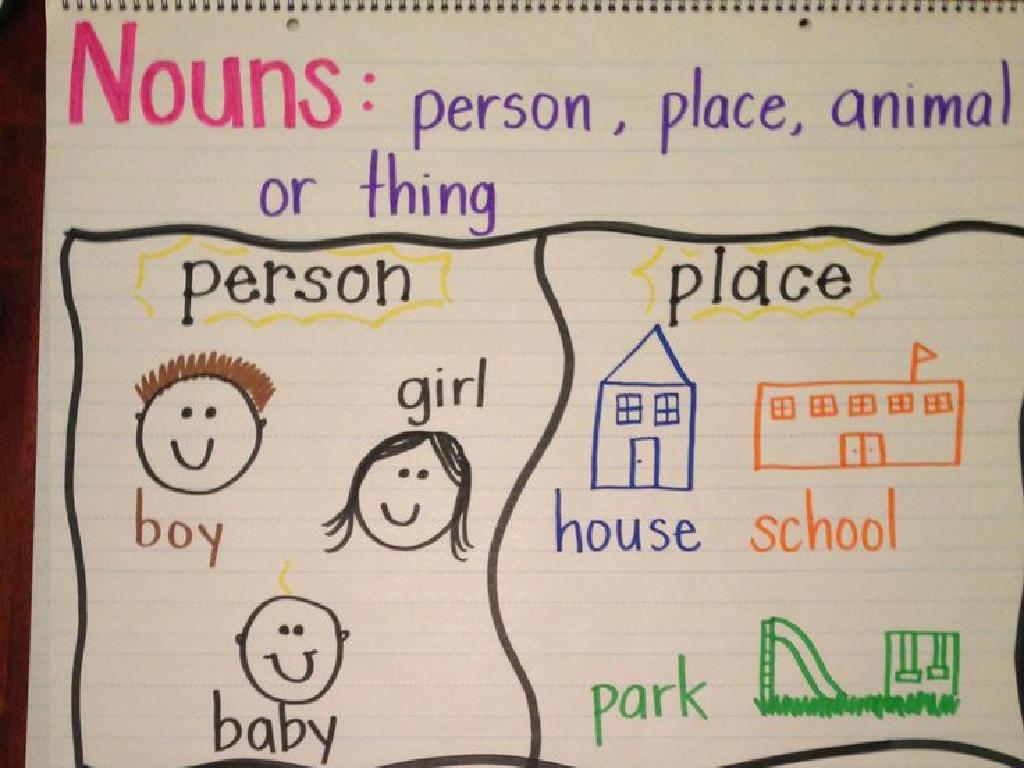Photosynthesis And Cellular Respiration
Subject: Science
Grade: High school
Topic: Biology
Please LOG IN to download the presentation. Access is available to registered users only.
View More Content
The Energy of Life: Photosynthesis & Cellular Respiration
– Life’s energy essentials
– All living things need energy to survive, which is obtained through different processes.
– Energy sources for flora & fauna
– Plants harness solar energy via photosynthesis, while animals rely on consuming organic matter.
– Photosynthesis: Solar to sugar
– In photosynthesis, plants convert sunlight into glucose, a sugar used as energy.
– Cellular Respiration: Sugar to energy
– Cellular respiration converts glucose into ATP, the energy currency for cells.
|
This slide introduces the fundamental concepts of how energy is obtained and utilized by living organisms. It sets the stage for a deeper dive into the processes of photosynthesis and cellular respiration. Photosynthesis is the process by which green plants and some other organisms use sunlight to synthesize foods with the help of chlorophyll pigments. Cellular respiration is the process all living organisms use to convert biochemical energy from nutrients into adenosine triphosphate (ATP), and then release waste products. The slide should emphasize the importance of these processes in the cycle of energy transfer in the biosphere and prepare students for more detailed exploration of each process.
Understanding Photosynthesis
– Define Photosynthesis
– The process plants use to convert light energy into chemical energy
– Photosynthesis Equation
– 6CO2 + 6H2O + light energy C6H12O6 + 6O2 represents the reactants and products
– Chlorophyll’s Function
– Chlorophyll captures light energy, initiating photosynthesis
– Chloroplasts’ Role
– Chloroplasts house chlorophyll and host the photosynthetic process
|
Photosynthesis is a fundamental biological process through which plants, algae, and some bacteria convert light energy into chemical energy, storing it as glucose. The equation 6CO2 + 6H2O + light energy C6H12O6 + 6O2 succinctly summarizes the transformation of carbon dioxide and water into glucose and oxygen, using light energy. Chlorophyll, the green pigment in plants, is crucial for absorbing the light energy required for this process. Chloroplasts, the cell organelles in plant cells, provide the environment where photosynthesis takes place. Understanding these concepts is essential for students to grasp how energy flows through ecosystems and the importance of plants in supporting life on Earth.
Stages of Photosynthesis: Harnessing Solar Energy
– Light-Dependent Reactions
– Occur in thylakoid membranes, convert light energy to chemical energy
– Light-Independent Reactions
– Known as the Calvin Cycle, occurs in stroma, doesn’t require light
– Role of ATP and NADPH
– ATP provides energy, NADPH provides electrons for the Calvin Cycle
– Photosynthesis significance
|
This slide aims to break down the complex process of photosynthesis into its two main stages for high school students. The light-dependent reactions are the initial phase where sunlight is captured and converted into chemical energy, specifically ATP and NADPH, which are crucial molecules for the next stage. The light-independent reactions, or the Calvin Cycle, use the energy from ATP and the electrons from NADPH to convert carbon dioxide into glucose. Emphasize the importance of these molecules in the energy conversion process. The significance of photosynthesis in converting solar energy into a form that can be used by living organisms should be highlighted, as it is the foundation for life on Earth.
Exploring Cellular Respiration
– Define cellular respiration
– A metabolic process converting nutrients into energy
– Cellular respiration equation
– Glucose + Oxygen Carbon dioxide + Water + Energy (ATP)
– Role of mitochondria
– Mitochondria: site of respiration & ATP production
– Energy release process
|
Cellular respiration is a crucial biological process where cells convert nutrients into ATP, the energy currency of the cell, and waste products. The simplified equation C6H12O6 + 6O2 6CO2 + 6H2O + energy illustrates the transformation of glucose and oxygen into carbon dioxide, water, and ATP. Mitochondria play a vital role in this process, often referred to as the ‘powerhouse of the cell,’ where the respiration cycle occurs. Understanding this process is key to grasping how cells obtain energy to perform various functions. Discuss the stages of cellular respiration, including glycolysis, the Krebs cycle, and the electron transport chain, to provide a comprehensive overview.
Stages of Cellular Respiration
– Glycolysis: Glucose breakdown
– Initial step in cellular respiration, splitting a glucose molecule into two pyruvate molecules.
– Krebs Cycle: Energy release
– A series of reactions that further break down pyruvate and produce NADH and FADH2 for the next stage.
– Electron Transport Chain: ATP production
– Uses electrons from NADH and FADH2 to power ATP synthesis, the cell’s energy currency.
|
This slide outlines the three key stages of cellular respiration, a process cells use to generate energy. Glycolysis is the first step, occurring in the cytoplasm, where glucose is converted into pyruvate, yielding 2 ATP molecules. The Krebs Cycle takes place in the mitochondria, processing pyruvate to produce electron carriers. The Electron Transport Chain is the final stage, where the energy from electrons transported by NADH and FADH2 is used to create a large amount of ATP. Emphasize the importance of each stage in the overall energy production and the efficiency of the process. Provide examples such as muscle cells during exercise for high ATP demand.
Comparing Photosynthesis and Cellular Respiration
– Both processes in energy cycle
– Both involve energy conversion and are crucial for life.
– Photosynthesis vs. Respiration
– Photosynthesis uses sunlight to produce glucose, while respiration breaks it down to release energy.
– Energy flow in ecosystems
– Photosynthesis stores energy, respiration releases it, cycling energy through the ecosystem.
– Plants and animals’ interdependence
– Plants produce oxygen and glucose for animals, animals provide carbon dioxide for plants.
|
This slide aims to highlight the fundamental similarities and differences between photosynthesis and cellular respiration, emphasizing their roles in the energy cycle of ecosystems. Both processes are essential for life, with photosynthesis converting solar energy into chemical energy and cellular respiration converting chemical energy into usable energy for organisms. The slide also touches on the symbiotic relationship between plants and animals, where the oxygen and glucose produced by plants during photosynthesis are vital for animals, and the carbon dioxide produced by animals during respiration is used by plants. Understanding these processes and their interdependence is crucial for students to grasp the concept of energy flow in ecosystems.
Real-Life Applications of Photosynthesis & Respiration
– Daily impact of photosynthesis
– Oxygen we breathe, food we eat originate from photosynthesis
– Oxygen & glucose significance
– Oxygen for respiration, glucose as energy source
– Photosynthesis in the carbon cycle
– Plants absorb CO2, helping regulate climate
– Cellular respiration & environment
– Respiration by organisms returns CO2 to the atmosphere
|
This slide aims to connect the concepts of photosynthesis and cellular respiration with students’ everyday experiences. Photosynthesis is not just a biological process but the foundation of life, providing the oxygen we breathe and the glucose that fuels our bodies. Emphasize the importance of these processes in maintaining the balance of oxygen and carbon dioxide in the atmosphere, which is crucial for life on Earth. Discuss how the carbon cycle is influenced by photosynthesis in plants, which acts as a carbon sink, and cellular respiration, which releases carbon dioxide back into the environment. Highlight the role these processes play in environmental health and the broader implications for climate change and ecosystem stability.
Class Activity: Photosynthesis & Respiration
– Lab: Photosynthesis in Aquatic Plants
– Observe oxygen bubble production as evidence of photosynthesis.
– Discuss: Glucose usage in our bodies
– How does the glucose from plants become energy in humans?
– Homework: Essay on Photosynthesis & Respiration
– Reflect on the cycle’s role in Earth’s life support.
– Understand life’s sustaining processes
|
This slide outlines a multi-part class activity designed to engage students in understanding the processes of photosynthesis and cellular respiration. The lab experiment involves observing photosynthesis in aquatic plants by looking for oxygen bubbles, which are a byproduct of the process. During the group discussion, students will explore how the glucose produced by plants during photosynthesis is used by our bodies for energy. For homework, students will write an essay on the importance of these processes in maintaining life on Earth, encouraging them to think critically about the interconnectedness of living organisms and the environment. Provide detailed guidelines for the lab and discussion to ensure a comprehensive understanding. Suggest possible discussion points and essay structures to help students organize their thoughts.






